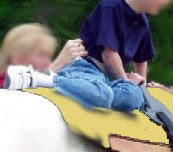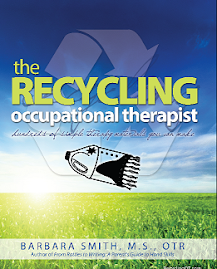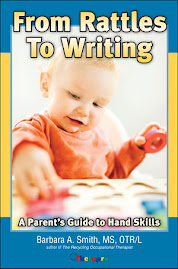
I rescued this plastic candy cane from the trash barrel at work. It was filled with a food treat for horses. After cleaning and scaping off the label it is perfect for an eye-hand coordination activity. It is used like a ring stack, except children need to do a little bit more motor planning to fit the ring over the curve of the cane. I can either hold the bottom so that the rings don't fall off or attach some type of barrier at the bottom with tape. This candy cane is thick enough to hold a vibrating squiggle wiggle pen (throw away the pen points) so that the activity becomes even more fun. Children are rewarded with holding the cane at the end of the activity.
This is a great activity to use during hippotherapy because children can reach for the rings or reach for the cane while placing them. Work while static or while horse is moving depending on the child's abilities. I like to have the horse walk as the child reaches for the rings and then stop when placing them. The halt/go cycle often increases body awareness and focus and of course, it is much easier to place the rings while the horse stops.
Squiggle Wiggle Writer by Hart Toys, Colors may vary
Barbara Smith, M.S., OTR/L, author of The Recycling Occupational Therapist
Horseot.com











